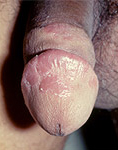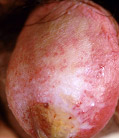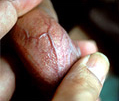Please note that this article is only for your information and you should always see your doctor if you have developed any symptoms and are uncertain if you have an STI.
Genital Rashes – Non-STI Related
The external genitalia are a common site for rashes, itching, and minor infections. The various possible causes can be discussed under the following categories: (1) Red (inflammatory patches) (2) White patches (3) Skin coloured lumps and bumps.
Endogenous eczema ('sensitive skin')
Red Patches

Patients may already have a history of eczema or 'sensitive skin', or they could initially experience itch that may be caused by a yeast infection, heat, moisture, or any irritant.
Repeated scratching can cause breaks in the skin and secondary infection. Over the scrotum, the skin can become very thickened, and can sometimes resemble 'elephant skin'. This is a process called 'lichenification'.
Treatment consists of topical corticosteroids, antihistamines and avoidance of irritants. Secondary infection of excoriated skin may require a course of antibiotics.
Contact dermatitis
This can occur as a result of irritation or from an allergic reaction to something applied.
The most common irritants are soaps, topical medicaments, urine, faeces and infected or copious vaginal secretions. Irritant contact dermatitis of the genitalia presents with redness and itching.
Lichen planus

This is a disease where the cause is unknown. It can affect the skin, mouth, nails and genitalia. It is usually itchy and causes pinkish or purplish small bumps to appear, sometimes with a lacy white streak on the surface. You should see your doctor if you suspect you have lichen planus. Topical corticosteroids are used for treatment.
Psoriasis

There are usually manifestations of psoriasis elsewhere on the body. Psoriasis is a chronic skin disorder that also affects the scalp and nails. It causes pinkish spots or small patches to appear on the genitalia, and may be itchy and scaly.
Fungal infection

Tinea cruris (jock itch) is caused by a ringworm type of fungus. It affects the groins. Candida is a type of yeast infection that causes vaginal discharge and rash, and also balanitis – an inflammation of the penis. If you have severe or recurrent candidal infections, you should see a doctor and conduct investigations to exclude diabetes.
Plasma cell (Zoon's) Mucositis

This presents as a balanitis in males. It appears as a moist, shiny, erythematous, well-demarcated plaque on the glans penis. It is benign and can be treated with a topical corticosteroid. However, a biopsy is often required to differentiate it from erythroplasia of Queyrat, which is a type of cancer occurring on the penis. Nearly all cases occur in uncircumcised males. Cause of this condition is unknown.
White Patches
Lichen sclerosus et atrophicus

Lichen sclerosus et atrophicus (LSA) and its male counterpart, balanitis xerotica obliterans (BXO) presents as ivory or porcelain-white, smooth and atrophic areas on the genitalia.
The cause is unknown, and it may be present for years before detection.
Treatment is difficult and usually includes the use of potent topical or intralesional corticosteroids, as well as topical testosterone propionate ointment. Circumcision may relieve symptoms in males.
Postinflammatory hypopigmentation
This can follow any inflammatory disorder and does not require any specific treatment.
Vitiligo

These are sharply demarcated areas of depigmentation. Pigment is lacking in these areas.
Skin Coloured Bumps
Pearly penile papules

These present as two or three rows of uniform, flesh-coloured papules running circumferentially around the corona. Onset is typically noted in the 20s and 30s. These things are not infectious and no treatment is required. They are often mistaken for warts.
Vestibular papillomatosis
These are also normal anatomical variants that occur on the mucous membrane of the introitus and labia minora and are often mistaken for warts. They are usually uniformly and symmetrically distributed, and are asymptomatic and require no treatment.
Ectopic sebaceous glands (Fordyce spots)

These are uniformly distributed, 1-2 mm flesh-coloured or yellowish papules that occur on the penile shaft as well as the labial surfaces. No treatment is required.